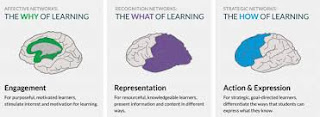Every course we teach is unique and has a diverse population of students within it. Have you ever thought about how to make the material richer for your students? Students differ in learning styles and abilities. By attempting to offer learning opportunities, engagement, and assessment in multiple formats we can help increase the learning and mastery of all our students.
Universal Design for Learning (UDL) is a design framework that guides instructors to plan and provide genuine learning opportunities and support for all students. I would assume that you are already doing this within your classrooms, both face to face and online. You have a project for students to complete, and they are given a choice in how they can show what they have learned. Maybe they write a paper, prepare a PowerPoint, create a wiki, vlog, or blog. UDL is an instructional design framework offering flexibility and adaptability to meet the needs of our diverse group of students with and without disabilities and to encourage maximum engagement. It is an intentional and systematic approach for building an environment that accommodates diversity and differences between and among our students, which fully supports our mission and vision here at ICC.
 |
| The why, what and how of learning |
- Present content and information in multiple modes – graphics, animation, activate background knowledge, support vocabulary.
- Give choices in demonstrating knowledge – action and expression – give students options on how to express what they know and show understanding in different ways.
- Multiple means of engagement – what motivates one student does not motivate the next, give students choices, help them risk mistakes and learn from them, keep in mind the learning goal when presenting your challenge.
UDL helps us to overcome unnecessary barriers within our classrooms. Implementation for UDL can be throughout the course or it can be looked at for each unit/module. Small changes are the way to start. Ask yourself what barriers or challenges students may be having within your class and start there.
Four critical elements of UDL implementation include: clear goals, intentional planning for learner variability, flexible methods and material, and timely progress monitoring.
By employing these principles and elements, your course content will be accessible to all students who might enroll in your course, including those with visual, auditory, or other impairments. It is a proactive approach that has potential to improve outcomes for our students.
CAST provides higher education faculty with a range of resources that supports integrating UDL into our current courses.
Visit their website for additional resources:
- CAST Home Page: http://udloncampus.cast.org/home
- Getting Started: What & Why
- UDL Guidelines
- The Basics of UDL (1 hour): Understanding POUR
- Examples of UDL being used across disciplines: education, music, construction management, criminal justice
- Critical Elements to UDL
Written by Janelle Reeb
Online Learning Coordinator
Feel free to leave comments below
Online Learning Coordinator
Feel free to leave comments below
For additional resources, visit icc.edu/tlc webpage

Comments
Post a Comment